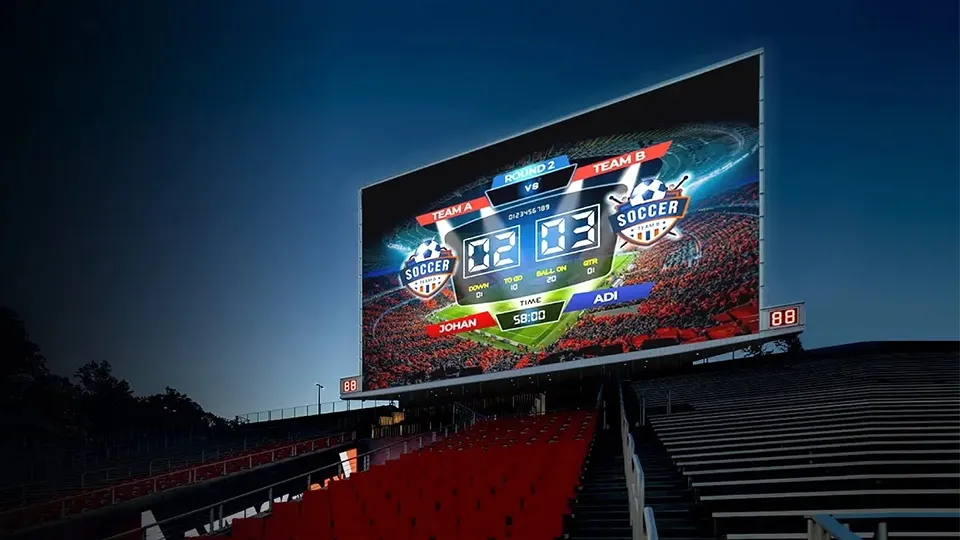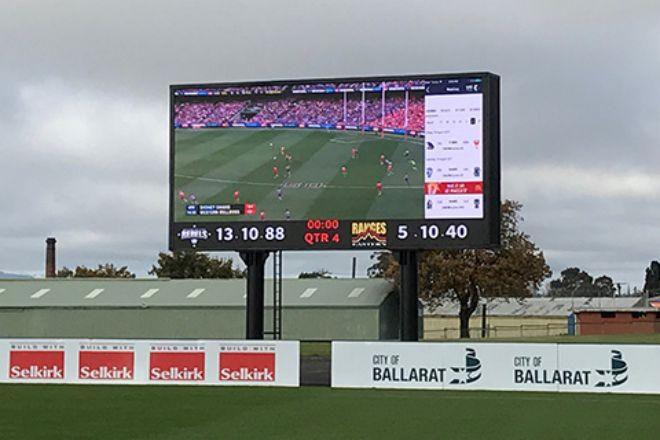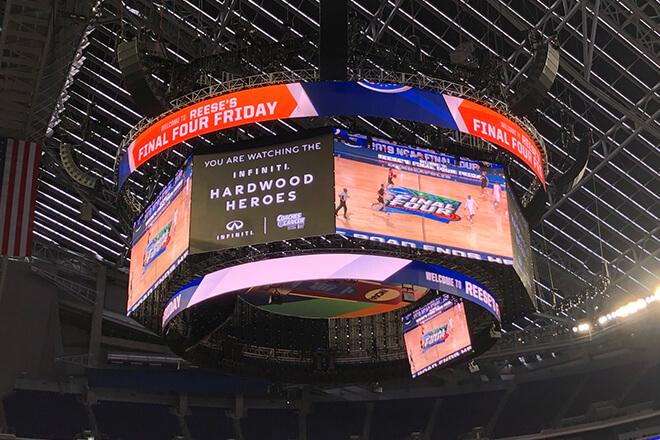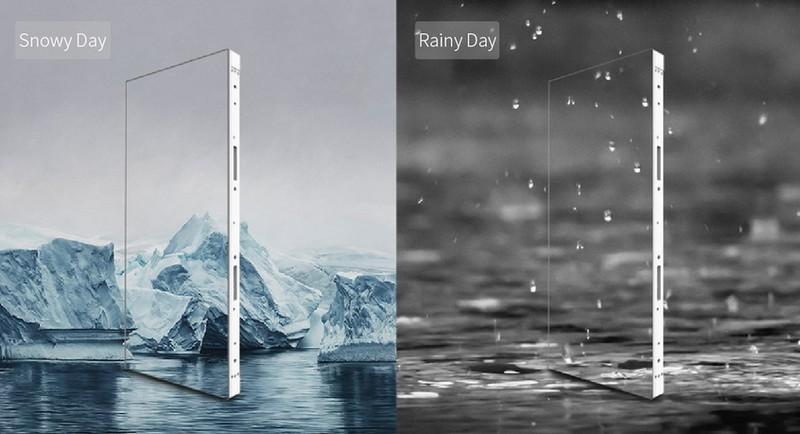In 2025, the LED screens in stadiums are quietly changing. They are no longer just for playing scores, but are becoming more flexible, better looking, and more interactive. Whether it is the game scene, advertising playback, or audience experience, a good screen is indispensable. The upgrade of stadium LED screens is not only a technological advancement, but also a part of the viewing experience.
1. Stadium LED screen trend
Stadium screens are getting bigger and bigger. This is not only a matter of "seeing clearly", but also part of the overall viewing experience. Many venues have begun to introduce large-format LED walls, covering the main stands, corners, and even multiple corners at the same time to ensure that every audience can see clear content.
Brightness is one of the most popular upgrade directions in 2025. For venues that host daytime events or open-air events, the screen must be able to maintain true colors and details in strong sunlight. The new generation of sports event LED displays generally use high-brightness chips and automatic photosensitive systems, which can adjust the display effect in real time according to the environment to avoid overexposure or darkening of the picture.
In addition, event organizers and advertisers are also paying more and more attention to exposure quality. A clear and stable venue screen can not only play scores and game pictures, but also insert brand content and dynamic animations in real time to attract the audience's attention, thereby improving advertising conversion.

The trend in 2025 is clear: whether it is building new venues or upgrading old ones, big screens are no longer a "supporting role". They have become an integral part of the visual operation of sports events, directly affecting audience satisfaction and commercial value.
2. Real-time content and interactive functions of Stadium LED screen
In modern sports events, the role of display screens is no longer just "displaying scores". Audiences expect not only the results, but also the rhythm of the process, the atmosphere of the scene, and the sense of participation brought by real-time interaction. This has also prompted many venues to upgrade to sports event LED displays that support dynamic content in 2025.
Now, more and more systems can synchronize game data, such as player scores, running distances, number of fouls, and even VAR playback information, and display them on large screens at the first time. These detailed information not only enhances the audience's sense of substitution, but also enhances the transparency and professionalism of the game.
In terms of commercial operations, dynamic LED scoreboards are being connected with advertising systems to achieve automatic switching of content. For example, when a player scores a goal, related brand advertisements can pop up instantly, creating exposure opportunities for sponsors that are more in line with the atmosphere of the scene. This type of "content linkage based on event behavior" is becoming an indispensable part of LED display solutions.
In addition, some large-scale sports events have also introduced functions such as audience voting, on-site lottery, and real-time push on social platforms. All these interactive contents need to be presented based on flexible event broadcasting screens. This type of screen not only has requirements for picture quality, but also needs to support high frame rate playback and background remote control.
It can be said that the LED display technology in 2025 is turning "watching the game" into an experience of "participating in the game".

3.Stadium LED screen is completely refreshing the technical standards
In sports competitions, whether the picture is smooth directly affects the audience's viewing experience. Especially when broadcasting slow motion, displaying playback or the camera follows high-speed movement, low refresh rate screens are prone to problems such as ghosting and flickering. The mainstream trend in 2025 is to use high refresh display for sports, with a refresh rate generally reaching above 3840Hz.
Such a technology upgrade not only serves the audience on site, but also takes special care of the broadcast needs. Many game images will be synchronized to TV stations or online platforms. Once the screen flickers, it may affect the shooting quality. High-definition cameras have much higher requirements for screens than the naked eye, which is why more and more venues choose sports playback screens that support high frame rates.
In addition, some on-site screens also need to display slow-motion analysis, tactical diagrams or multi-view switching, which puts higher requirements on picture stability. Using motion-friendly LED wall can ensure that the picture is not stuck or torn, and fans, commentators, and broadcast directors can get clear and smooth visual feedback.
Especially in fast-paced and action-heavy events such as basketball, racing, and tennis, high refresh rates are almost standard. If the live experience is not smooth enough, the audience may be "out of the show" or even miss key moments.
4. Customized stadium LED screen design to adapt to various venue structures

Different stadiums have different layouts. Some people value the panoramic surround feeling, while others need temporary construction and quick disassembly and assembly. Therefore, the trend in 2025 is: the screen form will be more diverse, the structural design will be more flexible, and it will be truly "customized according to the venue".
Many organizers have begun to choose customized LED display systems, which can not only be made into arc, L-shaped, and surround, but also can be adjusted according to structures such as columns, corners, and slopes to keep the picture intact and not deformed. This is particularly useful for some large-scale comprehensive venues. For example, an event with both a ball game and an opening ceremony performance requires "one screen for multiple uses".
For touring events or seasonal events, quick assembly and disassembly has become particularly important. Now there are many modular event LED walls on the market that support fast splicing and transportation, and even short-term events can achieve high-quality display effects. This type of solution is very suitable for temporary venues, such as street basketball leagues, e-sports outdoor competitions, marathon finish areas, etc.
Not only that, the screen size and ratio are becoming more and more liberal. In addition to the traditional 16:9, there are now ultra-wide strip screens, circular stand screens, column screens, top-mounted screens, etc. to meet different venue styles and visual needs.
5. Stadium LED screen weather resistance and energy saving

The display screens of outdoor sports venues face a complex and changeable natural environment. Strong sunlight, high temperature, rain, wind and sand, and even the cold in winter may affect the performance of the screen. In 2025, most outdoor LED scoreboards will reach IP65 and above protection levels, and their waterproof and dustproof capabilities will be significantly improved, which can ensure long-term stable operation during the event, and will not cause abnormal screens or failures due to weather problems.
In addition, energy saving has become an important consideration for procurement. The new generation of outdoor display screens generally use high-efficiency LED chips and intelligent power management systems, which can automatically adjust the brightness according to the ambient light and reduce energy consumption. For large sports venues, the energy consumption of long-term high-brightness operation cannot be ignored. Energy-saving design can significantly reduce operating costs, reduce equipment heat, and increase life.
Weather resistance and energy saving are important yardsticks for the quality of outdoor screens, which directly affect the normal progress of the event and the viewing experience of the audience. Choosing an outdoor sports display with these advantages can provide more stable and reliable visual support for the venue and improve the professional level of the overall event.
6.Conclusion
Among the many suppliers, companies with rich industry experience and technical accumulation can provide customized design, stable and durable products, and perfect after-sales support, becoming the most trusted partners for B-side customers. For example, LEGIDATECH has been deeply involved in the field of sports display for many years. According to the needs of different venues and events, it can provide one-stop services from solution design to installation and maintenance, helping customers stand out in the fierce market competition.
1. Stadium LED screen trend
Stadium screens are getting bigger and bigger. This is not only a matter of "seeing clearly", but also part of the overall viewing experience. Many venues have begun to introduce large-format LED walls, covering the main stands, corners, and even multiple corners at the same time to ensure that every audience can see clear content.
Brightness is one of the most popular upgrade directions in 2025. For venues that host daytime events or open-air events, the screen must be able to maintain true colors and details in strong sunlight. The new generation of sports event LED displays generally use high-brightness chips and automatic photosensitive systems, which can adjust the display effect in real time according to the environment to avoid overexposure or darkening of the picture.
In addition, event organizers and advertisers are also paying more and more attention to exposure quality. A clear and stable venue screen can not only play scores and game pictures, but also insert brand content and dynamic animations in real time to attract the audience's attention, thereby improving advertising conversion.
The trend in 2025 is clear: whether it is building new venues or upgrading old ones, big screens are no longer a "supporting role". They have become an integral part of the visual operation of sports events, directly affecting audience satisfaction and commercial value.
2. Real-time content and interactive functions of Stadium LED screen
In modern sports events, the role of display screens is no longer just "displaying scores". Audiences expect not only the results, but also the rhythm of the process, the atmosphere of the scene, and the sense of participation brought by real-time interaction. This has also prompted many venues to upgrade to sports event LED displays that support dynamic content in 2025.
Now, more and more systems can synchronize game data, such as player scores, running distances, number of fouls, and even VAR playback information, and display them on large screens at the first time. These detailed information not only enhances the audience's sense of substitution, but also enhances the transparency and professionalism of the game.
In terms of commercial operations, dynamic LED scoreboards are being connected with advertising systems to achieve automatic switching of content. For example, when a player scores a goal, related brand advertisements can pop up instantly, creating exposure opportunities for sponsors that are more in line with the atmosphere of the scene. This type of "content linkage based on event behavior" is becoming an indispensable part of LED display solutions.
In addition, some large-scale sports events have also introduced functions such as audience voting, on-site lottery, and real-time push on social platforms. All these interactive contents need to be presented based on flexible event broadcasting screens. This type of screen not only has requirements for picture quality, but also needs to support high frame rate playback and background remote control.
It can be said that the LED display technology in 2025 is turning "watching the game" into an experience of "participating in the game".
3.Stadium LED screen is completely refreshing the technical standards
In sports competitions, whether the picture is smooth directly affects the audience's viewing experience. Especially when broadcasting slow motion, displaying playback or the camera follows high-speed movement, low refresh rate screens are prone to problems such as ghosting and flickering. The mainstream trend in 2025 is to use high refresh display for sports, with a refresh rate generally reaching above 3840Hz.
Such a technology upgrade not only serves the audience on site, but also takes special care of the broadcast needs. Many game images will be synchronized to TV stations or online platforms. Once the screen flickers, it may affect the shooting quality. High-definition cameras have much higher requirements for screens than the naked eye, which is why more and more venues choose sports playback screens that support high frame rates.
In addition, some on-site screens also need to display slow-motion analysis, tactical diagrams or multi-view switching, which puts higher requirements on picture stability. Using motion-friendly LED wall can ensure that the picture is not stuck or torn, and fans, commentators, and broadcast directors can get clear and smooth visual feedback.
Especially in fast-paced and action-heavy events such as basketball, racing, and tennis, high refresh rates are almost standard. If the live experience is not smooth enough, the audience may be "out of the show" or even miss key moments.
4. Customized stadium LED screen design to adapt to various venue structures
Different stadiums have different layouts. Some people value the panoramic surround feeling, while others need temporary construction and quick disassembly and assembly. Therefore, the trend in 2025 is: the screen form will be more diverse, the structural design will be more flexible, and it will be truly "customized according to the venue".
Many organizers have begun to choose customized LED display systems, which can not only be made into arc, L-shaped, and surround, but also can be adjusted according to structures such as columns, corners, and slopes to keep the picture intact and not deformed. This is particularly useful for some large-scale comprehensive venues. For example, an event with both a ball game and an opening ceremony performance requires "one screen for multiple uses".
For touring events or seasonal events, quick assembly and disassembly has become particularly important. Now there are many modular event LED walls on the market that support fast splicing and transportation, and even short-term events can achieve high-quality display effects. This type of solution is very suitable for temporary venues, such as street basketball leagues, e-sports outdoor competitions, marathon finish areas, etc.
Not only that, the screen size and ratio are becoming more and more liberal. In addition to the traditional 16:9, there are now ultra-wide strip screens, circular stand screens, column screens, top-mounted screens, etc. to meet different venue styles and visual needs.
5. Stadium LED screen weather resistance and energy saving
The display screens of outdoor sports venues face a complex and changeable natural environment. Strong sunlight, high temperature, rain, wind and sand, and even the cold in winter may affect the performance of the screen. In 2025, most outdoor LED scoreboards will reach IP65 and above protection levels, and their waterproof and dustproof capabilities will be significantly improved, which can ensure long-term stable operation during the event, and will not cause abnormal screens or failures due to weather problems.
In addition, energy saving has become an important consideration for procurement. The new generation of outdoor display screens generally use high-efficiency LED chips and intelligent power management systems, which can automatically adjust the brightness according to the ambient light and reduce energy consumption. For large sports venues, the energy consumption of long-term high-brightness operation cannot be ignored. Energy-saving design can significantly reduce operating costs, reduce equipment heat, and increase life.
Weather resistance and energy saving are important yardsticks for the quality of outdoor screens, which directly affect the normal progress of the event and the viewing experience of the audience. Choosing an outdoor sports display with these advantages can provide more stable and reliable visual support for the venue and improve the professional level of the overall event.
6.Conclusion
Among the many suppliers, companies with rich industry experience and technical accumulation can provide customized design, stable and durable products, and perfect after-sales support, becoming the most trusted partners for B-side customers. For example, LEGIDATECH has been deeply involved in the field of sports display for many years. According to the needs of different venues and events, it can provide one-stop services from solution design to installation and maintenance, helping customers stand out in the fierce market competition.
